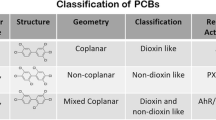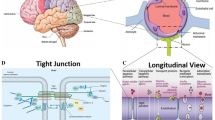Abstract
Environmental polychlorinated biphenyls (PCBs) are frequently bound onto nanoparticles (NPs). However, the toxicity and health effects of PCBs assembled onto nanoparticles are unknown. The aim of this study was to study the hypothesis that binding PCBs to silica NPs potentiates PCB-induced cerebrovascular toxicity and brain damage in an experimental stroke model. Mice (C57BL/6, males, 12-week-old) were exposed to PCB153 bound to NPs (PCB153-NPs), PCB153, or vehicle. PCB153 was administered in the amount of 5 ng/g body weight. A group of treated animals was subjected to a 40 min ischemia, followed by a 24 h reperfusion. The blood–brain barrier (BBB) permeability, brain infarct volume, expression of tight junction (TJ) proteins, and inflammatory mediators were assessed. As compared to controls, a 24 h exposure to PCB153-NPs injected into cerebral vasculature resulted in significant elevation of the BBB permeability, disruption of TJ protein expression, increased proinflammatory responses, and enhanced monocyte transmigration in mouse brain capillaries. Importantly, exposure to PCB153-NPs increased stroke volume and potentiated brain damage in mice subjected to ischemia/reperfusion. A long-term (30 days) oral exposure to PCB153-NPs resulted in a higher PCB153 content in the abdominal adipose tissue and amplified adhesion of leukocytes to the brain endothelium as compared to treatment with PCB153 alone. This study provides the first evidence that binding to NPs increases cerebrovascular toxicity of environmental toxicants, such as PCB153.






Similar content being viewed by others
References
Abbott NJ, Ronnback L, Hansson E (2006) Astrocyte-endothelial interactions at the blood–brain barrier. Nat Rev Neurosci 7:41–53
Albelda SM, Smith CW, Ward PA (1994) Adhesion molecules and inflammatory injury. FASEB J 8:504–512
Alexander JS, Elrod JW (2002) Extracellular matrix, junctional integrity and matrix metalloproteinase interactions in endothelial permeability regulation. J Anat 200:561–574
ATSDR (Agency for Toxic Substances and Disease Registry) (2000) Health Consultation: Evaluation of Soil, Blood, and Air Data from Anniston, Alabama, Calhoun County, Alabama. Atlanta, GA:ATSDR. http://www.atsdr.cdc.gov/hac/pha/pha.asp?docid=930&pg=0. Accessed 6 August 2012.
Borm PJ, Robbins D, Haubold S, Kuhlbusch T, Fissan H, Donaldson K, Schins R, Stone V, Kreyling W, Lademann J, Krutmann J, Warheit D, Oberdorster E (2006) The potential risks of nanomaterials: a review carried out for ECETOC. Part Fibre Toxicol 3:11
Calderon-Garciduenas L, Solt AC, Henriquez-Roldan C, Torres-Jardon R, Nuse B, Herritt L, Villarreal-Calderon R, Osnaya N, Stone I, Garcia R, Brooks DM, Gonzalez-Maciel A, Reynoso-Robles R, Delgado-Chavez R, Reed W (2008) Long-term air pollution exposure is associated with neuroinflammation, an altered innate immune response, disruption of the blood–brain barrier, ultrafine particulate deposition, and accumulation of amyloid beta-42 and alpha-synuclein in children and young adults. Toxicol Pathol 36:289–310
Campelo JM, Luna D, Luque R, Marinas JM, Romero AA (2009) Sustainable preparation of supported metal nanoparticles and their applications in catalysis. ChemSusChem 2:18–45
Chen L, Swartz KR, Toborek M (2009) Vessel microport technique for applications in cerebrovascular research. J Neurosci Res 87:1718–1727
Chen L, Choi JJ, Choi YJ, Hennig B, Toborek M (2011) HIV-1 Tat-induced cerebrovascular toxicity is enhanced in mice with amyloid deposits. Neurobiol Aging.
Chen L, Zhang B, Toborek M (2012) Autophagy is involved in nanoalumina-induced cerebrovascular toxicity. Nanomedicine.
Choi W, Eum SY, Lee YW, Hennig B, Robertson LW, Toborek M (2003) PCB 104-induced proinflammatory reactions in human vascular endothelial cells: relationship to cancer metastasis and atherogenesis. Toxicol Sci 75:47–56
Choi YJ, Seelbach MJ, Pu H, Eum SY, Chen L, Zhang B, Hennig B, Toborek M (2010) Polychlorinated biphenyls disrupt intestinal integrity via NADPH oxidase-induced alterations of tight junction protein expression. Environ Health Perspect 118:976–981
Chrysikou LP, Gemenetzis PG, Samara CA (2009) Wintertime size distribution of polycyclic aromatic hydrocarbons (PAHs), polychlorinated biphenyls (PCBs) and organochlorine pesticides (OCPs) in the urban environment: Street- vs rooftop-level measurements. Atmospheric Environment 43:290–300
Crinnion WJ (2011) Polychlorinated biphenyls: persistent pollutants with immunological, neurological, and endocrinological consequences. Alternative Med Rev 16:5–13
de Vries HE, Kuiper J, de Boer AG, Van Berkel TJ, Breimer DD (1997) The blood–brain barrier in neuroinflammatory diseases. Pharmacol Rev 49:143–155
Dziennis S, Yang D, Cheng J, Anderson KA, Alkayed NJ, Hurn PD, Lein PJ (2008) Developmental exposure to polychlorinated biphenyls influences stroke outcome in adult rats. Environ Health Perspect 116:474–480
El-Ansary A, Al-Daihan S (2009) On the toxicity of therapeutically used nanoparticles: an overview. J Toxicol 2009:754810
Eum SY, Andras I, Hennig B, Toborek M (2009) NADPH oxidase and lipid raft-associated redox signaling are required for PCB153-induced upregulation of cell adhesion molecules in human brain endothelial cells. Toxicol Appl Pharmacol 240:299–305
Fu S, Cheng HX, Liu YH, Yang ZZ, Xu XB (2009) Spatial character of polychlorinated biphenyls from soil and respirable particulate matter in Taiyuan, China. Chemosphere 74:1477–1484
Fullerton SM, Shirman GA, Strittmatter WJ, Matthew WD (2001) Impairment of the blood-nerve and blood–brain barriers in apolipoprotein e knockout mice. Exp Neurol 169:13–22
Goncharov A, Bloom M, Pavuk M, Birman I, Carpenter DO (2010) Blood pressure and hypertension in relation to levels of serum polychlorinated biphenyls in residents of Anniston, Alabama. J Hypertens 28:2053–2060
Hansen LG (1998) Stepping backward to improve assessment of PCB congener toxicities. Environ Health Perspect 106(Suppl 1):171–189
Haorah J, Ramirez SH, Schall K, Smith D, Pandya R, Persidsky Y (2007) Oxidative stress activates protein tyrosine kinase and matrix metalloproteinases leading to blood–brain barrier dysfunction. J Neurochem 101:566–576
Hartz AM, Bauer B, Block ML, Hong JS, Miller DS (2008) Diesel exhaust particles induce oxidative stress, proinflammatory signaling, and P-glycoprotein up-regulation at the blood–brain barrier. FASEB J 22:2723–2733
Hawkins BT, Davis TP (2005) The blood–brain barrier/neurovascular unit in health and disease. Pharmacol Rev 57:173–185
Hawkins BT, Egleton RD (2008) Pathophysiology of the blood–brain barrier: animal models and methods. Curr Top Dev Biol 80:277–309
Hennig B, Reiterer G, Majkova Z, Oesterling E, Meerarani P, Toborek M (2005) Modification of environmental toxicity by nutrients: implications in atherosclerosis. Cardiovasc Toxicol 5:153–160
Lake JL, Mckinney R, Lake CA, Osterman FA, Heltshe J (1995) Comparisons of patterns of polychlorinated biphenyl congeners in water, sediment, and indigenous organisms from New-Bedford Harbor, Massachusetts. Arch Environ Contam Toxicol 29:207–220
Lee YW, Eum SY, Chen KC, Hennig B, Toborek M (2004) Gene expression profile in interleukin-4-stimulated human vascular endothelial cells. Mol Med 10:19–27
Lo EH, Dalkara T, Moskowitz MA (2003) Mechanisms, challenges and opportunities in stroke. Nat Rev Neurosci 4:399–415
Lockman PR, Mumper RJ, Khan MA, Allen DD (2002) Nanoparticle technology for drug delivery across the blood–brain barrier. Drug Dev Ind Pharm 28:1–13
Lockman PR, Koziara JM, Mumper RJ, Allen DD (2004) Nanoparticle surface charges alter blood–brain barrier integrity and permeability. J Drug Target 12:635–641
Napierska D, Thomassen LC, Rabolli V, Lison D, Gonzalez L, Kirsch-Volders M, Martens JA, Hoet PH (2009) Size-dependent cytotoxicity of monodisperse silica nanoparticles in human endothelial cells. Small 5:846–853
Nemmar A, Inuwa IM (2008) Diesel exhaust particles in blood trigger systemic and pulmonary morphological alterations. Toxicol Lett 176:20–30
Nisbet IC, Sarofim AF (1972) Rates and routes of transport of PCBs in the environment. Environ Health Perspect 1:21–38
Norstrom K, Czub G, McLachlan MS, Hu D, Thorne PS, Hornbuckle KC (2010) External exposure and bioaccumulation of PCBs in humans living in a contaminated urban environment. Environ Int 36:855–861
Oberdorster G, Sharp Z, Atudorei V, Elder A, Gelein R, Kreyling W, Cox C (2004) Translocation of inhaled ultrafine particles to the brain. Inhal Toxicol 16:437–445
Pellegrin S, Mellor H (2007) Actin stress fibres. J Cell Sci 120:3491–3499
Peters A, Veronesi B, Calderon-Garciduenas L, Gehr P, Chen LC, Geiser M, Reed W, Rothen-Rutishauser B, Schurch S, Schulz H (2006) Translocation and potential neurological effects of fine and ultrafine particles a critical update. Part Fibre Toxicol 3:13
Prince MM, Ruder AM, Hein MJ, Waters MA, Whelan EA, Nilsen N, Ward EM, Schnorr TM, Laber PA, Davis-King KE (2006) Mortality and exposure response among 14,458 electrical capacitor manufacturing workers exposed to polychlorinated biphenyls (PCBs). Environ Health Perspect 114:1508–1514
Roberts JW, Dickey P (1995) Exposure of children to pollutants in house dust and indoor air. Rev Environ Contam Toxicol 143:59–78
Rosenberg GA, Estrada EY, Dencoff JE (1998) Matrix metalloproteinases and TIMPs are associated with blood–brain barrier opening after reperfusion in rat brain. Stroke 29:2189–2195
Saghir SA, Hansen LG, Holmes KR, Kodavanti PR (2000) Differential and non-uniform tissue and brain distribution of two distinct 14C-hexachlorobiphenyls in weanling rats. Toxicol Sci 54:60–70
Seelbach M, Chen L, Powell A, Choi YJ, Zhang B, Hennig B, Toborek M (2010) Polychlorinated biphenyls disrupt blood–brain barrier integrity and promote brain metastasis formation. Environ Health Perspect 118:479–484
Shcherbatykh I, Huang X, Lessner L, Carpenter DO (2005) Hazardous waste sites and stroke in New York State. Environ Health 4:18
Shiu C, Barbier E, Di Cello F, Choi HJ, Stins M (2007) HIV-1 gp120 as well as alcohol affect blood–brain barrier permeability and stress fiber formation: involvement of reactive oxygen species. Alcohol Clin Exp Res 31:130–137
Silverstone AE, Rosenbaum PF, Weinstock RS, Bartell SM, Foushee HR, Shelton C, Pavuk M (2012) Polychlorinated biphenyl (PCB) exposure and diabetes: results from the Anniston Community Health Survey. Environ Health Perspect 120:727–732
Sipka S, Eum SY, Son KW, Xu S, Gavalas VG, Hennig B, Toborek M (2008) Oral administration of PCBs induces proinflammatory and prometastatic responses. Environ Toxicol Pharmacol 25:251–259
Sipos E, Chen L, Andras IE, Wrobel J, Zhang B, Pu H, Park M, Eum SY, Toborek M (2012) Proinflammatory adhesion molecules facilitate polychlorinated biphenyl-mediated enhancement of brain metastasis formation. Toxicol Sci 126:362–371
Stanimirovic D, Satoh K (2000) Inflammatory mediators of cerebral endothelium: a role in ischemic brain inflammation. Brain Pathol 10:113–126
Valavanidis A, Fiotakis K, Vlachogianni T (2008) Airborne particulate matter and human health: toxicological assessment and importance of size and composition of particles for oxidative damage and carcinogenic mechanisms. J Environ Sci Health C Environ Carcinog Ecotoxicol Rev 26:339–362
Wong D, Prameya R, Dorovini-Zis K (2007) Adhesion and migration of polymorphonuclear leukocytes across human brain microvessel endothelial cells are differentially regulated by endothelial cell adhesion molecules and modulate monolayer permeability. J Neuroimmunol 184:136–148
Yamada H, Takayanagi K, Tateishi M, Tagata H, Ikeda K (1997) Organotin compounds and polychlorinated biphenyls of livers in squid collected from coastal waters and open oceans. Environ Pollut 96:217–226
Zhang B, Chen L, Swartz KR, Bruemmer D, Eum SY, Huang W, Seelbach M, Choi YJ, Hennig B, Toborek M (2010) Deficiency of telomerase activity aggravates the blood–brain barrier disruption and neuroinflammatory responses in a model of experimental stroke. J Neurosci Res 88:2859–2868
Zhong Y, Smart EJ, Weksler B, Couraud PO, Hennig B, Toborek M (2008) Caveolin-1 regulates human immunodeficiency virus-1 Tat-induced alterations of tight junction protein expression via modulation of the Ras signaling. J Neurosci 28:7788–7796
Acknowledgments
This study was supported by the grants from the National Institutes of Health (NIH) ES07380, CA133257, MH63022, MH072567, and DA027569. We would like to thank Dr. Yinan Wei (Department of Chemistry, University of Kentucky) for PCB analysis.
Conflict of interest
The authors declare that they have no conflict of interest.
Author information
Authors and Affiliations
Corresponding author
Rights and permissions
About this article
Cite this article
Zhang, B., Chen, L., Choi, J.J. et al. Cerebrovascular Toxicity of PCB153 is Enhanced by Binding to Silica Nanoparticles. J Neuroimmune Pharmacol 7, 991–1001 (2012). https://doi.org/10.1007/s11481-012-9403-y
Received:
Accepted:
Published:
Issue Date:
DOI: https://doi.org/10.1007/s11481-012-9403-y




